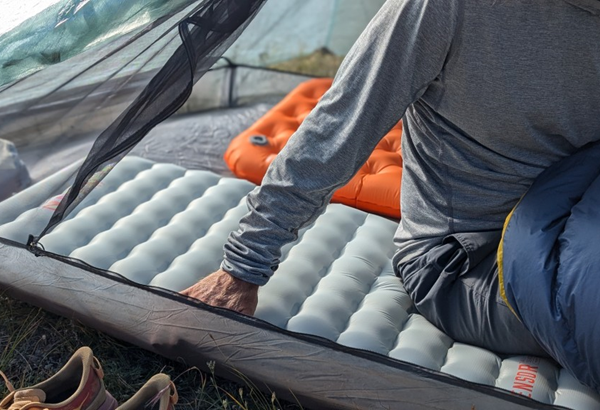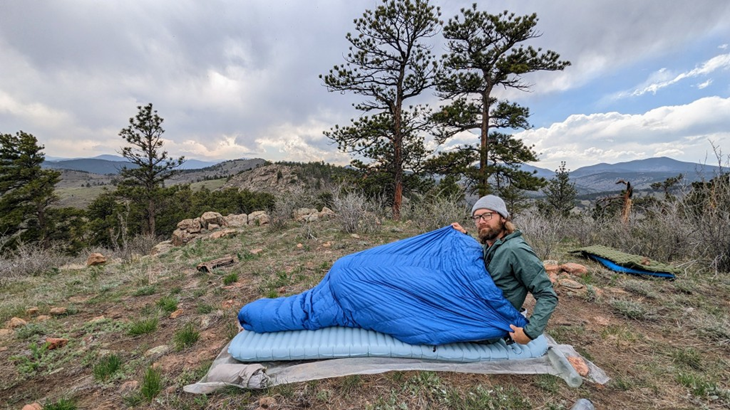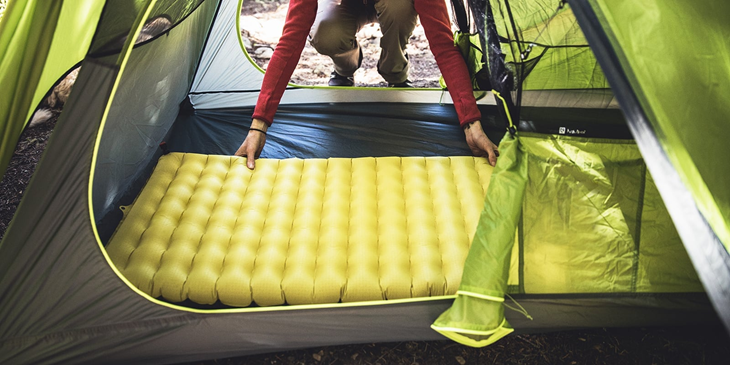11
Feb

There’s little worse than lying awake and staring at the roof of your tent while your adventure buddies saw logs. And, while tossing and turning you keep on wondering whether it’s possible to get a good night’s sleep when camping. The answer is yes as long as you carry a sleeping mat. While it might seem like having a comfortable surface to sleep on is a pad’s most useful function, its ability to keep you warm throughout the night is even more important. Here’s how to choose your sleeping pad for camping or backpacking.
Read more: No More Restless Nights Under the Stars: A Simple Guide to Hiking Mats for Sleeping
Say goodbye to restless sleep at night under the starry sky with a lightweight and compact sleeping mat for hiking. Camping sleeping mats come in three different flavours: closed-cell foam, self-inflating, and air construction.
A self-inflated camping sleeping mat uses an open-celled foam placed between two layers of fabric. These have an air valve that you may open to allow the pad to “self-inflate.” When the valve is opened, the foam expands, inflating the pad. The foam also traps and retains heat. The latest pad variants take around five minutes to inflate, but older ones with compressed foam will take longer and require more breaths from you to fully inflate.
Keep in mind that the term “self-inflating” is a bit misleading, since all of these pads require a few breaths to achieve optimal firmness after the foam has expanded. To maximise the life of the foam, keep it semi-inflated rather than compacted.
When people hear the word “camping,” they usually think of a closed-cell foam sleeping mat for hiking. These traditional camping mats are far from as comfy as inflatable air-construction pads, for obvious reasons. They are made of a thin foam layer, which is often combined with heat-reflective material to provide further insulation. Closed-cell foam cushions provide a significant benefit in terms of durability. Because there is no vulnerable air chamber, these pads will not pop, leaving you with no cushioning to sleep in. These are often lightweight and are an excellent way to add more insulation to an inflatable camping sleeping pad.
“Air Construction,” or inflatable sleeping pads, have dominated the hiking pad market. There are hundreds of models that meet this description. These pads are often plush and lightweight. However, insulation levels vary greatly, from those capable of protecting you from snow beneath to those only suitable for summer camping. At their core, Air Construction pads are thin laminated textiles filled with air, allowing the user to vary pad firmness and gain much-needed lift above the hard ground and trash that traditionally caused long nights.
Sleeping pad R Values are the outdoor industry’s best attempt to standardise how warm a sleeping mat is. The ability of heat to flow from hot to cold through materials is measured using an R-value. As one might imagine, the R-value determines the insulating properties of many other goods, such as residential walls.
Unlike EN testing, R values for sleeping pads are not determined by a uniform, independent body. As a result, no mat can be assigned the same “correct” R Value. Every manufacturer takes a distinct method of testing. However, they are all generally accurate.
You may note that sleeping pads come in “insulated” and “uninsulated” types, which complicates matters even more. In most circumstances, these two pads are identical; nevertheless, the insulated pad has a greater R-value and, on occasion, a more resilient fabric.
As a result, always examine the temperature rating of your camping gear or the R-value connected with a specific pad and base your decision on the most common weather conditions in your location. No pad is superior or worse simply because it has a higher R-value; similarly, a pad is not always “uninsulated” or has an R-value of 1.

Ultra-light pads are ideal for backpacking, although they are pricier. You can save weight by selecting a mummy or tapered shape, which decreases volume and packs smaller. Closed-cell foam pads in short lengths are likewise quite lightweight. If you’re hiking with a partner, a two-person lightweight sleeping mat can help you save weight.
At a minimum, your shoulders and hips must fit on a pad. Regular (72-inch) and long (78-inch) cushions help insulate your legs and feet, which is especially useful on chilly fall and winter journeys. A short or 3/4-length pad (typically 47 or 48 inches) is lighter and packs more compactly.
Nearly all pads have a standard width of 20 inches. If you’re a large person or like to roll around a lot, you might require a width of 25 or 30 inches. Often, the “long” form of a pad is also broader, but in some styles, a wide pad might be “regular” length. Some pads include larger side baffles, often known as “rails,” that cradle you and prevent you from falling off as you turn during sleep. These are especially suitable for children.